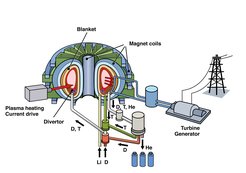Layout and function
A fusion power plant will be of shell-shaped structure. The energy-supplying fusion plasma is located at the core.

The hot deuterium-tritium plasma in a ring-shaped combustion chamber is kept away from the "first wall" by magnetic fields. Till ignition a start-up heating system supplies the plasma for a few seconds with a power of 50 to 100 megawatts. The fast helium nuclei resulting from the ensuing fusion reactions are trapped in the magnetic field as charged particles and transfer their energy to the plasma through particle collisions. Ultimately, external heating can be almost totally switched off; the plasma maintains the fusion temperatures through self-heating.
The divertor removes the helium "ash" emerging from the plasma in order not to extinguish of the fusion fire. The electrically neutral neutrons can leave the magnetic field cage without hindrance. They impinge on the blanket surrounding the plasma vessel, where they produce the tritium fuel from lithium. This fuel is collected and re-admitted to the plasma together with deuterium via intermediate storages. A 1000 MW power plant will need about 20 grams of tritium and 13 grams of deuterium per hour.
The blanket also absorbs the energy of the neutrons: The fast particles are decelerated in the blanket material, thus heating it. This thermal energy is then converted to electric energy by means of coolants, heat exchangers, and turbogenerators.
The blanket is enclosed in a sheath that screens the magnets, heating facilities, and the other surroundings from radiation and neutrons. The entire power plant core is finally enclosed in an external safety shield.
For information on a stellarator power plant see IPP's "Stellarator Systems Studies" group.
